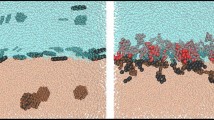Abstract
The effect of added compatibilizer on the strain recovery of model immiscible blends after cessation of shear was studied. Blends were composed of polyisobutylene drops (up to 30% by weight) in a polydimethylsiloxane matrix, with viscosity ratio (viscosity of the drops relative to the matrix viscosity) ranging from 0.3 to 1.7. Up to 1% by weight of a PIB-PDMS diblock copolymer was added as compatibilizer. The ultimate recovery recorded after reaching steady-shear conditions increased significantly due to added compatibilizer. Furthermore, the compatibilizer also slowed down the kinetics of the recovery; however, unlike uncompatibilized blends, the recovery could no longer be captured by a single retardation time. The largest increase in ultimate recovery due to compatibilizer occurred at the lowest viscosity ratio. In contrast, the greatest slowing down of the recovery due to compatibilizer occurred at the highest viscosity ratio. The rheological data by themselves are insufficient to reach a definitive conclusion about the mechanism of compatibilizer action. The results are consistent with the effects of flow-induced gradients in compatibilizer concentration. An alternative constitutive modeling approach that captures compatibilizer effects in terms of an interfacial dilational elasticity can reproduce the recovery curves qualitatively, but some predictions of the model contradict experimental results.









Similar content being viewed by others
References
Edwards DA, Brenner D, Wasan DT (1991) Interfacial transport processes and rheology. Butterworth-Heinemann, Boston
Jacobs U, Fahrländer M, Winterhalter J, Friedrich C (1999) Analysis of Palierne’s emulsion model in the case of viscoelastic interfacial properties. J Rheol 43:1497–1509
Li X, Pozrikidis C (1997) The effect of surfactants on drop deformation and on the rheology of dilute emulsions in Stokes flow. J Fluid Mech 341:165–194
Luciani A, Champagne MF, Utracki LA (1997) Interfacial tension coefficient from the retraction of ellipsoidal drops. J Polym Sci Part B Polym Phys 35:1393–1403
Milliken WJ, Leal LG (1994) The influence of surfactant on the deformation and breakup of a viscous drop: The effect of surfactant solubility. J Colloid Interface Sci 166:275–285
Oldroyd JG (1953) The elastic and viscous properties of emulsions and suspensions. Proc R Soc Lond A218:122–132
Oldroyd JG (1955) The effect of interfacial stabilizing films on the elastic and viscous properties of emulsions. Proc R Soc Lond A232:567–577
Palierne JF (1990) Linear rheology of viscoelastic emulsions with interfacial tension. Rheol Acta 29:204–214
Pawar Y, Stebe K (1996) Marangoni effects on drop deformation in an extensional flow: the role of surfactant physical chemistry. 1. Insoluble surfactants. Phys Fluids 8:1738–1751
Riemann RE, Cantow HJ, Friedrich C (1997) Interpretation of a new interface-governed relaxation process in compatibilized polymer blends. Macromolecules 30:5476–5484
Stone HA, Leal LG (1990) The effects of surfactants on drop deformation and breakup. J Fluid Mech 220:161–186
Van Hemelrijck E, Van Puyvelde P, Velankar S, Macosko CW, Moldenaers P (2004) Interfacial elasticity and coalescence suppression in compatibilized polymer blends. J Rheol 48:143–158
Van Puyvelde P, Velankar S, Mewis J, Moldenaers P (2002) Effect of Marangoni stresses on the deformation and coalescence in compatibilized immiscible polymer blends. Polym Eng Sci 42:1956–1964
Velankar S, Van Hemelrijck E, Van Puyvelde P, Moldenaers P, Macosko CW (2001a) Shear-induced coalescence in compatibilized polymer blends. In: Proceedings of the 3rd Pacific Rim Conference on Rheology
Velankar S, Van Puyvelde P, Mewis J, Moldenaers P (2001b) Effect of compatibilization on the breakup of polymeric drops in shear flow. J Rheol 45:1007–1019
Velankar S, Van Puyvelde P, Mewis J, Moldenaers P (2004a) Steady-shear rheological properties of model compatibilized blends. J Rheol 48:725–744
Velankar S, Zhou H, Jeon HK, Macosko CW (2004b) CFD evaluation of drop retraction methods for the measurement of interfacial tension of surfactant-laden drops. J Colloid Interface Sci 272:172–185
Vinckier I, Mewis J, Moldenaers P (1999a) Elastic recovery of immiscible blends 2.Transient flow histories. Rheol Acta 38:198–205
Vinckier I, Moldenaers P, Mewis J (1999b) Elastic Recovery of immiscible blends 1. Analysis after steady state shear flow. Rheol Acta 38:65–72
Acknowledgements
We gratefully acknowledge the Laboratory of Applied Rheology at the Katholieke Universiteit Leuven for making the PIB-PMDS diblock copolymer available for this research. Funding for this research was provided by the University of Pittsburgh and by the Petroleum Research Fund of the ACS (Grant PRF# 39931-G9).
Author information
Authors and Affiliations
Corresponding author
Appendix
Appendix
The equations below are given by Jacobs et al. (1999). We correct a typographical error in those equations (Eq. 11 in Jacobs paper has (1 − (3/2) ϕ) in the denominator whereas (1+(3/2) ϕ) is correct).
The relaxation and retardation times are given by
Equations 24 and 25 are in a slightly different algebraic form than those provided by Jacobs et al. (1999): since λ11 and λ21 both remain finite in the limit of β/α=0, (24) and (25) are slightly more convenient than those given by Jacobs et al. Finally, all the above times can be made dimensionless by multiplying by the steady shear rate \(\dot{\gamma}_{0}:\)
Rights and permissions
About this article
Cite this article
Wang, J., Velankar, S. Strain recovery of model immiscible blends: effects of added compatibilizer. Rheol Acta 45, 741–753 (2006). https://doi.org/10.1007/s00397-005-0038-2
Received:
Accepted:
Published:
Issue Date:
DOI: https://doi.org/10.1007/s00397-005-0038-2




